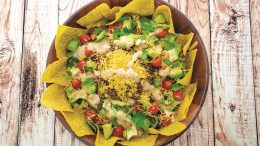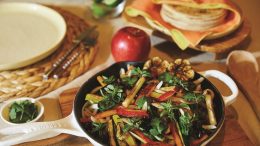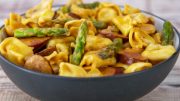Extending the harvesting season is the primary method I use to garden year-round. It involves using a variety of methods to harvest fresh food over as long a season as possible – you will probably use different techniques for different crops. On this page I will review methods used to extend your harvests during the growing season. I will explain how to harvest fresh food from your garden throughout the winter, beginning in the section Winter Vegetables.
Select the Right Varieties
In addition to selecting varieties that will grow better in either colder or warmer weather, you can select varieties that naturally produce a harvest over several weeks. Pole snap beans often produce fresh bean pods several weeks longer than bush beans.
Some varieties of broccoli plants continue to produce side shoots over several weeks – side shoots are small heads of broccoli that grow after you harvest the main head. I am still harvesting side shoots from my broccoli plants in early December, after giving them a little protection from the cold weather.
Indeterminate tomatoes keep growing and producing fruit as long as the weather stays warm enough and the plants don’t die from a disease. Determinate tomatoes ripen a lot of fruit all at once – which is useful if you want to can most of your fruit at one time, but not so helpful if you just want to pick a few ripe tomatoes every week throughout the summer.
You can also harvest many fruit crops over an extended period, if you choose the right varieties. Everbearing strawberries, such as Tristar, can produce fresh strawberries for several months. If you plant several different varieties of blueberries or dwarf apple trees (early, mid, and late season), you can extend your harvest over weeks or months.
You can also select varieties of fruit and vegetables that are easily stored for long periods of time, either in cool rooms in your home, in make-shift root cellars, or in cold frames in your garden. My onions, garlic, winter squash, and sweet potatoes will last for 6-10 months in a cool room in my home.
Plant Multiple Crops During the Growing Season
With quickly maturing vegetables like lettuce, carrots, miniature cabbages, and bush beans, you can start a few plants every 2-3 weeks, and extend your fresh harvest over many months. Some cool-season crops (such as spinach) do not germinate or grow well during the hottest months, so for those crops you might plant seeds a few times in the spring and again in the fall.
I love watermelon so much that I plant a fast 75-day variety monthly – inside water cloches on April 15th, and in uncovered garden beds on May 15th, June 15, and July 15th. I can harvest these melons from early July through early October. Or you could plant early, mid-season, and late-maturing varieties all at the same time as another way to harvest the crop over several months.
I’ve recently learned that my favorite early variety, Blacktail Mountain, can be harvested a little early and these melons will then gradually ripen over several weeks – unlike most varieties, which will just start rotting a couple weeks after harvest. I plan to grow a couple extra plants at the end of the season, pick the watermelons just before they become fully ripe, and enjoy ripe fruit from late October through part of November.
I only plant tomatoes twice – early varieties in water cloches four weeks before I plant my main indeterminate varieties around the last average frost date in May. This allows me to harvest fresh tomatoes from early July until my first frost in fall. I then harvest the remaining large green tomatoes to bring inside. They will gradually ripen over a few more weeks, although their flavor isn’t as good.
You will have to experiment to learn what schedule will work best in your climate, or ask what successful gardeners in your neighborhood do.
If you live in an area with very hot summers, you might have to take a break in planting any crops during the worst of the heat – or you might find some vegetables that love the heat and do well. If you have extremely short, cool summers, you might not be able to grow multiple summer crops, and you might focus more on cool-season vegetables instead.
How late can you plant your frost-sensitive crops?
Fall crops take longer to mature than spring crops. To figure out how late you can plant your tender fall crops, add up the following days:
- Days to maturity: 49 days (example for one variety of bush beans)
- Slower growth: 10-14 days (plants take longer to grow in the shorter daylight hours in late summer)
- Harvest time: 14 days (allow a week or two to harvest a frost-sensitive crop before first frost) Note: you won’t need to add this time for cool-season crops, as they tolerate light frosts well
- Total: 77 days (11 weeks) If your first average frost date is October 15th, then the last date you should plant this crop would be around July 30th.
If you have an unusually early frost, you might lose this crop. However, you might also be able to protect these plants from a light frost by covering them with row covers.
Some people take a chance, and plant another crop even later, hoping for a late fall frost. Because you are only risking a few seeds planted within a few square feet, it doesn’t hurt to take a chance if you want to.
So, for bush beans (or other fast-maturing tender summer crops), if you just want a couple servings a week during the summer, you might plant 4 plants in one square foot (6′′ apart) every 2-4 weeks from your last average spring frost date (mid-May in my area) until the last safe date to plant (July 30th in the above example).
On the other hand, if you want to can or freeze extra beans, you might want to plant half a bed all at one time (about 8 square feet). I was able to can a lot of tomatoes and beans from one small 4′ x 4′ bed – I trellised 4 tomato plants (2 each on the north and south sides of the bed) and planted bush beans in the middle.
I also plant peas around July 4th to harvest fresh pods in the fall just before the first fall frosts. This planting, in addition to my two spring plantings, often allow me to harvest fresh snap peas for nearly 8-12 weeks during the year, far longer than most gardeners think is possible. My fall peas survive light frosts down to about 28 degrees. These mature plants and ripe pods are more sensitive to freezing temps than are young pea plants in spring. Of course, this schedule works well for me in the mid-Atlantic region. You will have to experiment to find out what planting schedule will work best in your climate.
Keep Plants Picked Clean
Another secret to extending your harvest is to pick ALL of your beans and peas. If your plants are looking healthy, don’t let any pods stay on your plants and get fat and old. Many plants will focus all their energy on producing seed instead of producing new flowers, if you allow seeds to set and mature.
If I keep my pea or bean plants picked clean, they will often start producing a whole new set of blossoms and a second crop to harvest. This method also applies to other crops, such as summer squash. I would not use this technique if the plants are looking sick or covered with insect pests, or if I want to harvest everything in this section of garden bed to plant a different crop.
Protect Your Late Crops
Small raised garden beds make it easier to protect your smaller late fall crops. It’s not very practical to protect trellised crops from a hard freeze (unless you can remove them from the trellis, lie them on the ground, and cover them with heavy row covers or blankets).
Article by abundantminigardens.com.
This educational blog is a series of informative articles from the Penn State Master Gardeners volunteers plus news concerning the group and their activities. For more information, click here.










































